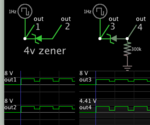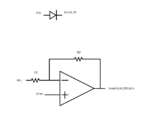Follow along with the video below to see how to install our site as a web app on your home screen.
Note: This feature may not be available in some browsers.
You care about SNR.But use the resistors as voltage divider will reduce the SNR.
This is about no information.I want to obtain step response amplitude between initial and steady state voltage.
A DVM, a scope?Is there a another method? QQ
There is no voltage drop on the two nodes of the diode when connecting it between the input signal and the ADC, so I guess the method of using the diode might not work.

